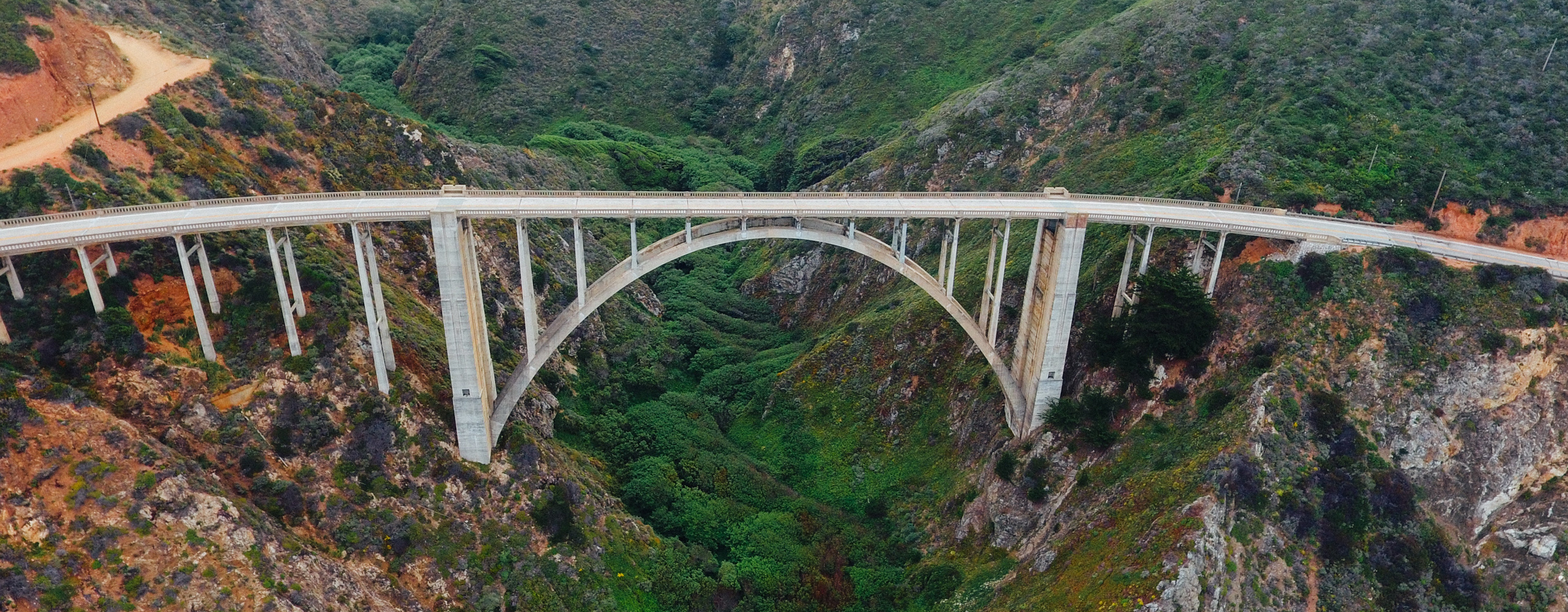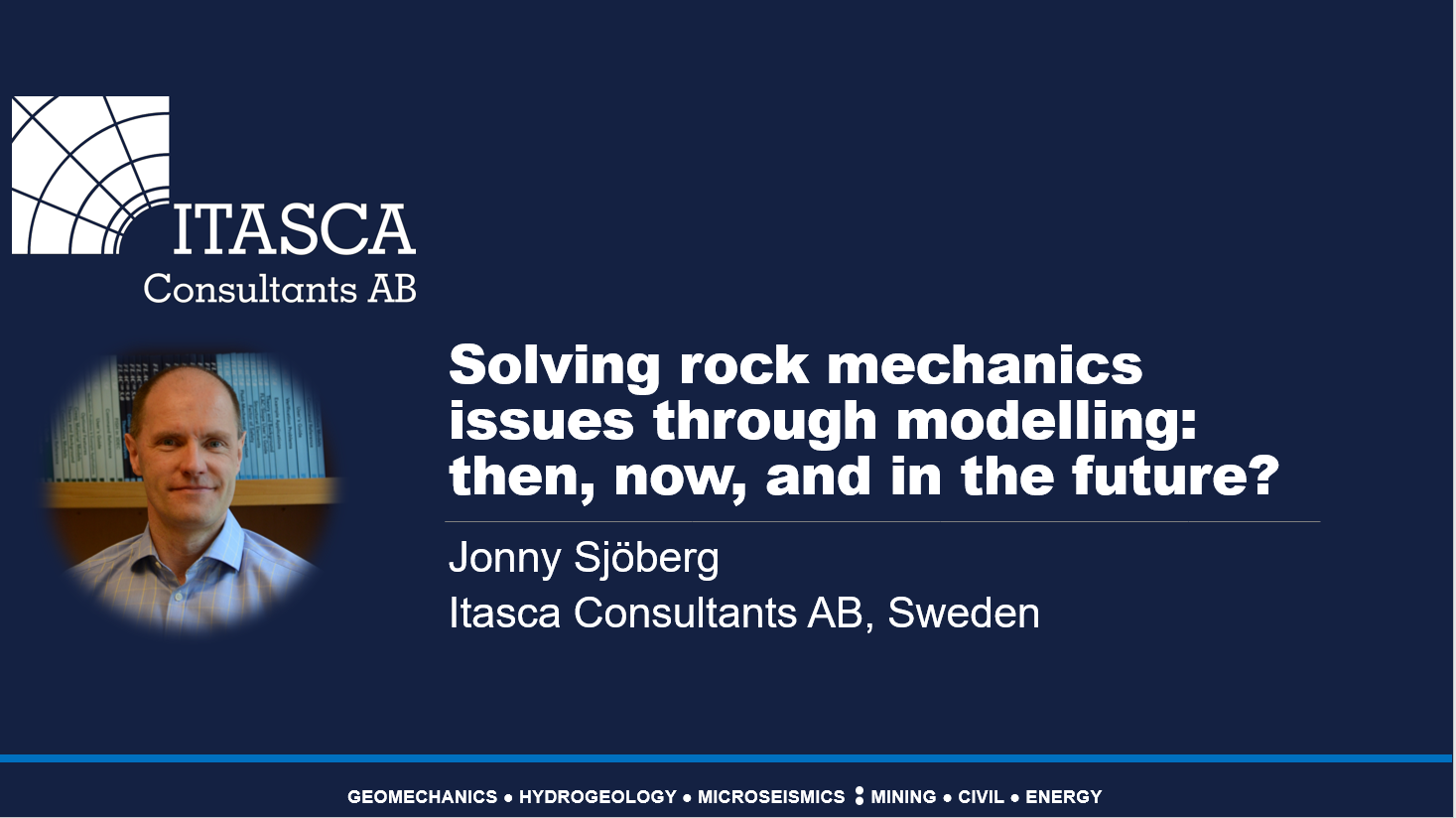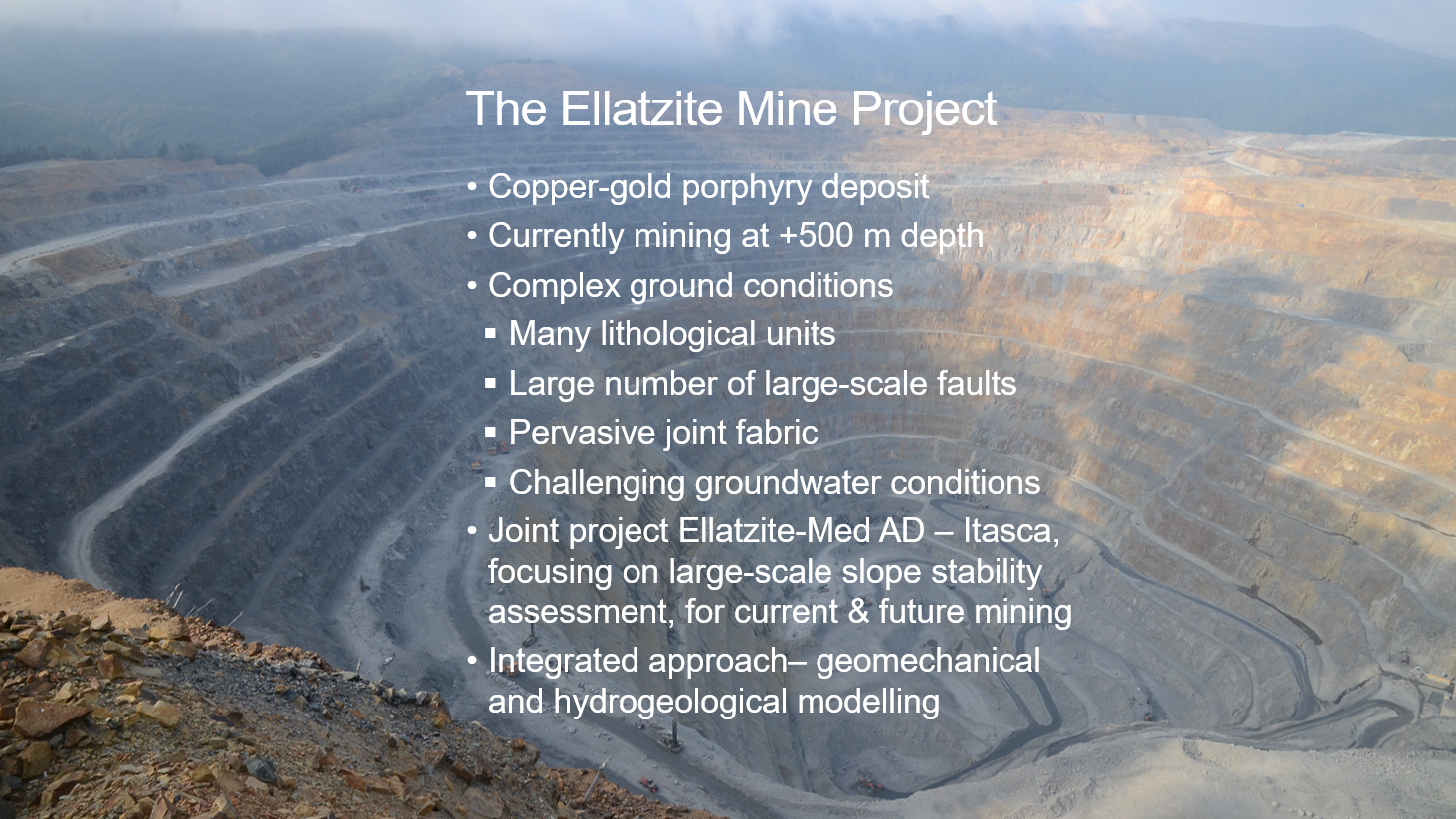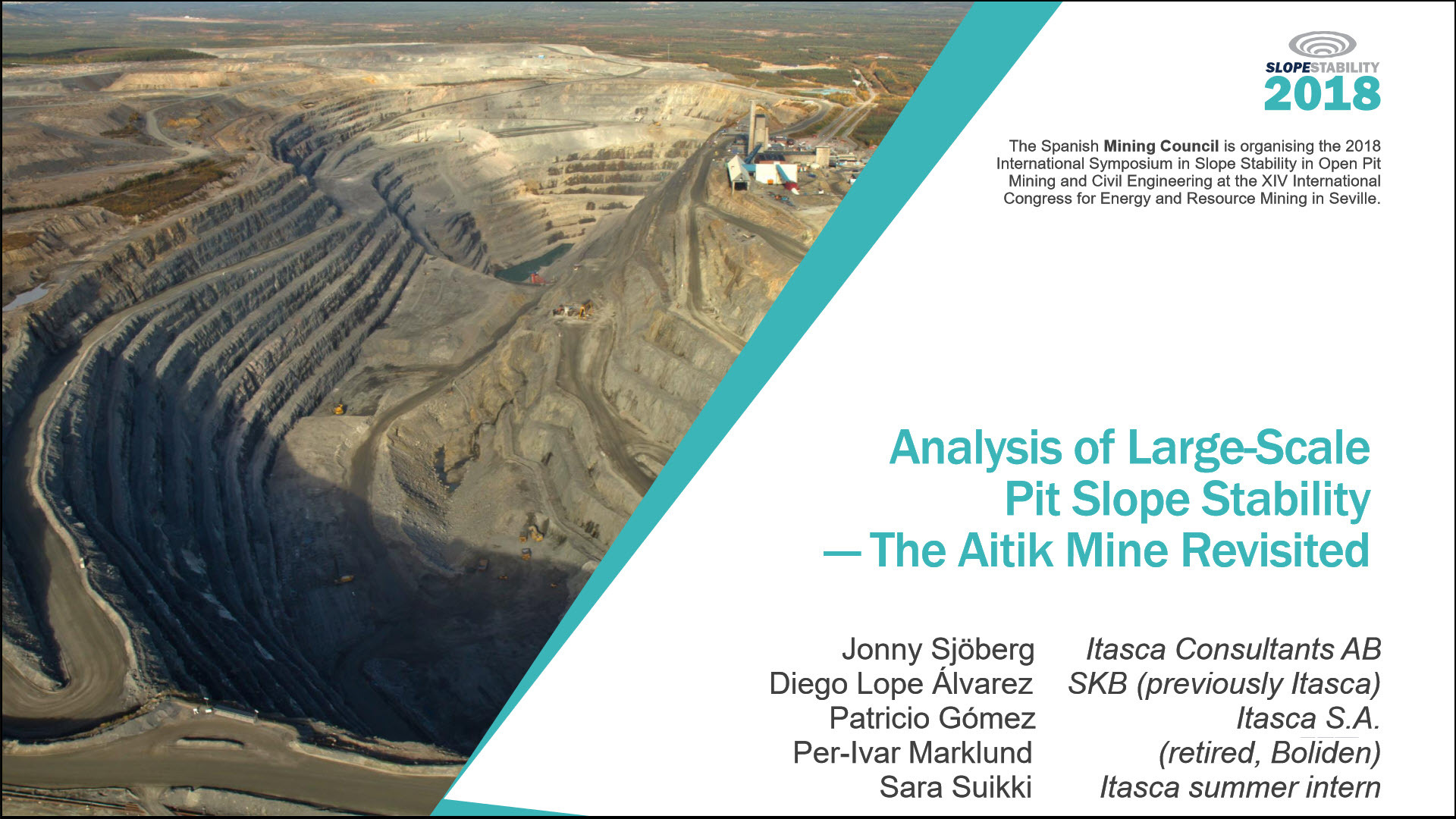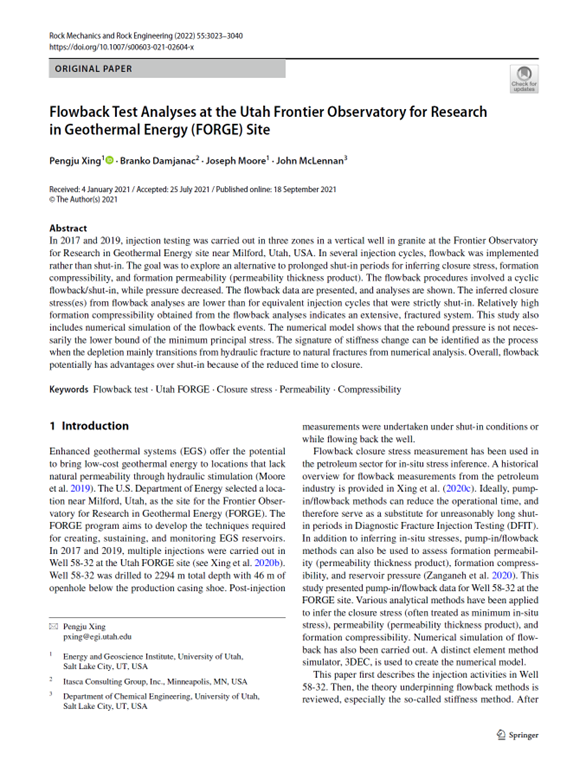
Flowback Test Analyses at the Utah Frontier Observatory for Research in Geothermal Energy (FORGE) Site
Injection testing conducted in 2017 and 2019 at the Frontier Observatory for Research in Geothermal Energy (FORGE) site in Utah evaluated flowback as an alternative to prolonged shut-in periods to infer closure stress, formation compressibility, and formation permeability. Flowback analyses yielded lower inferred closure stresses than traditional shut-in methods and indicated high formation compressibility, suggesting an extensive fractured system. Numerical simulations showed rebound pressure is not necessarily the lower bound of minimum principal stress. Stiffness changes can be identified as depletion transitions from hydraulic to natural fractures. The advantage if flowback is reduced time to closure.
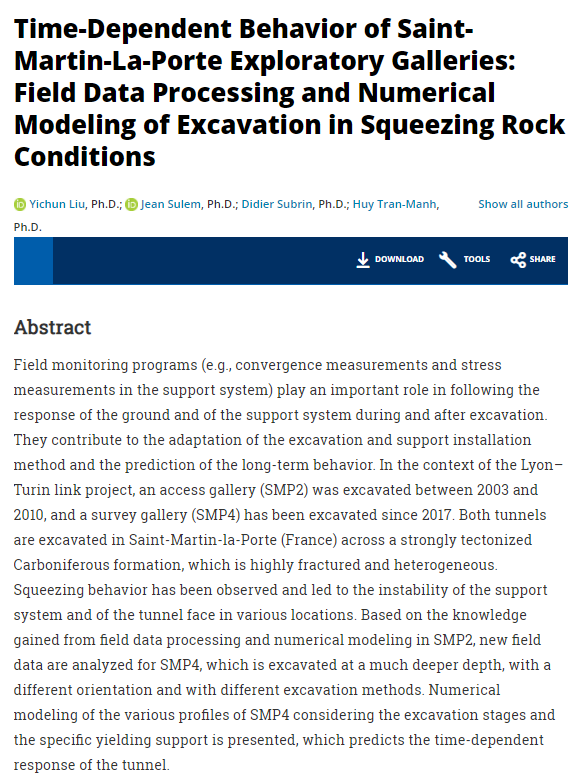
Time-Dependent Behavior of Saint-Martin-La-Porte Exploratory Galleries: Field Data Processing and Numerical Modeling of Excavation in Squeezing Rock Conditions
Field monitoring programs (e.g., convergence measurements and stress measurements in the support system) play an important role in following the response of the ground and of the support system during and after excavation. They contribute to the adaptation of the excavation and support installation method and the prediction of the long-term behavior. In the context of the Lyon–Turin link project, an access gallery (SMP2) was excavated between 2003 and 2010, and a survey gallery (SMP4) has been excavated since 2017.
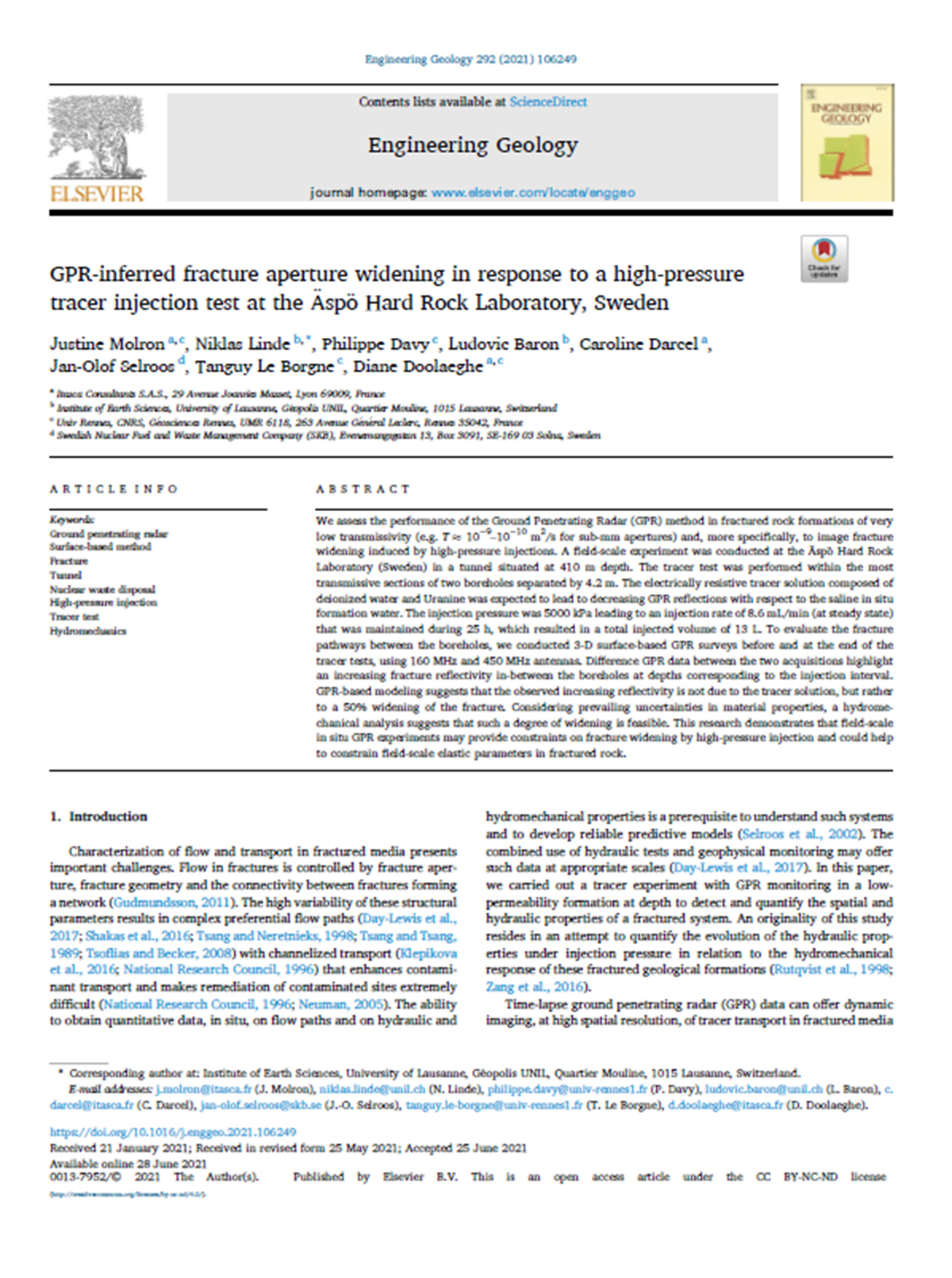
GPR-inferred fracture aperture widening in response to a high-pressure tracer injection test at the Äspö Hard Rock Laboratory, Sweden
We assess the performance of the Ground Penetrating Radar (GPR) method in fractured rock formations of very low transmissivity (e.g. T ≈ 10−9–10−10 m2/s for sub-mm apertures) and, more specifically, to image fracture widening induced by high-pressure injections. A field-scale experiment was conducted at the Äspö Hard Rock Laboratory (Sweden) in a tunnel situated at 410 m depth. The tracer test was performed within the most transmissive sections of two boreholes separated by 4.2 m. The electrically resistive tracer solution composed of deionized water and Uranine was expected to lead to decreasing GPR reflections with respect to the saline in situ formation water.
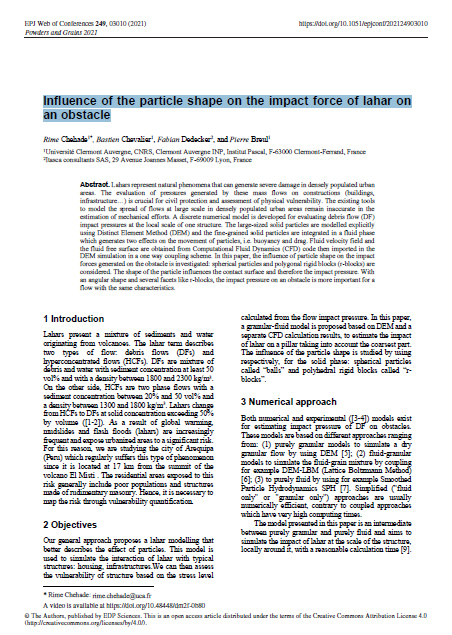
Influence of the particle shape on the impact force of lahar on an obstacle
Lahars represent natural phenomena that can generate severe damage in densely populated urban areas. The evaluation of pressures generated by these mass flows on constructions (buildings, infrastructure…) is crucial for civil protection and assessment of physical vulnerability. The existing tools to model the spread of flows at large scale in densely populated urban areas remain inaccurate in the estimation of mechanical efforts. A discrete numerical model is developed for evaluating debris flow (DF) impact pressures at the local scale of one structure.
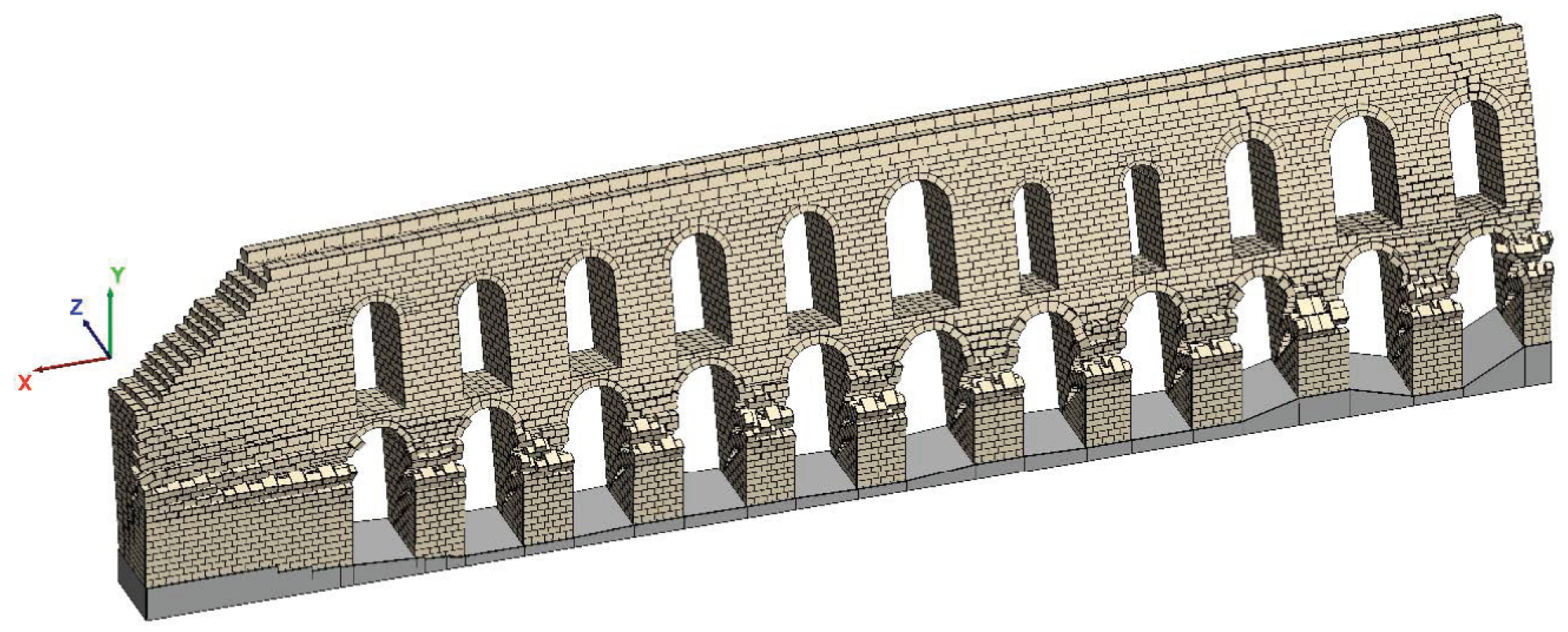
Quasi-Static Nonlinear Seismic Assessment of a Fourth Century A.D. Roman Aqueduct in Istanbul, Turkey
This paper presents a model of a stone masonry Roman aqueduct (the Valens Aqueduct), constructed in the fourth century A.D. in Istanbul, Turkey, to explore the seismic capacity and behavior using the discrete element method (DEM).
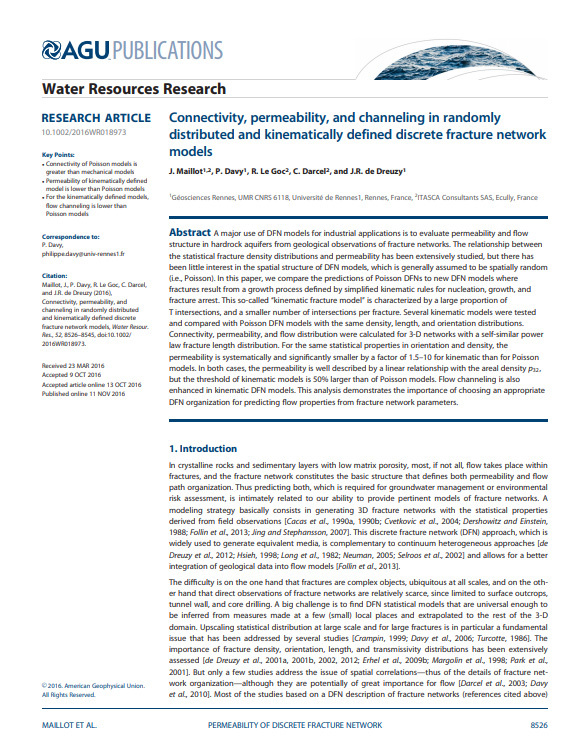
Connectivity, permeability, and channeling in randomly distributed and kinematically defined discrete fracture network models
A major use of DFN models for industrial applications is to evaluate permeability and flow structure in hardrock aquifers from geological observations of fracture networks. The relationship between the statistical fracture density distributions and permeability has been extensively studied, but there has been little interest in the spatial structure of DFN models, which is generally assumed to be spatially random (i.e., Poisson). In this paper, we compare the predictions of Poisson DFNs to new DFN models where fractures result from a growth process defined by simplified kinematic rules for nucleation, growth, and fracture arrest.
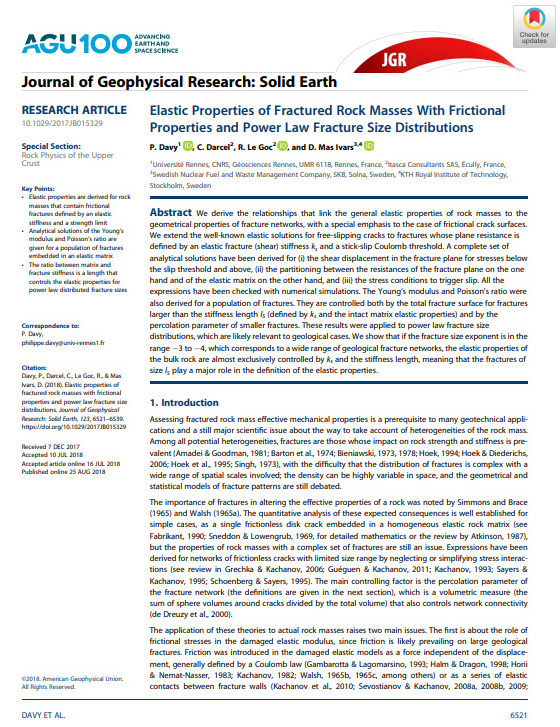
Elastic Properties of Fractured Rock Masses With Frictional Properties and Power Law Fracture Size Distributions
We derive the relationships that link the general elastic properties of rock masses to the geometrical properties of fracture networks, with a special emphasis to the case of frictional crack surfaces.
We extend the well-known elastic solutions for free-slipping cracks to fractures whose plane resistance is defined by an elastic fracture (shear) stiffness ks and a stick-slip Coulomb threshold.
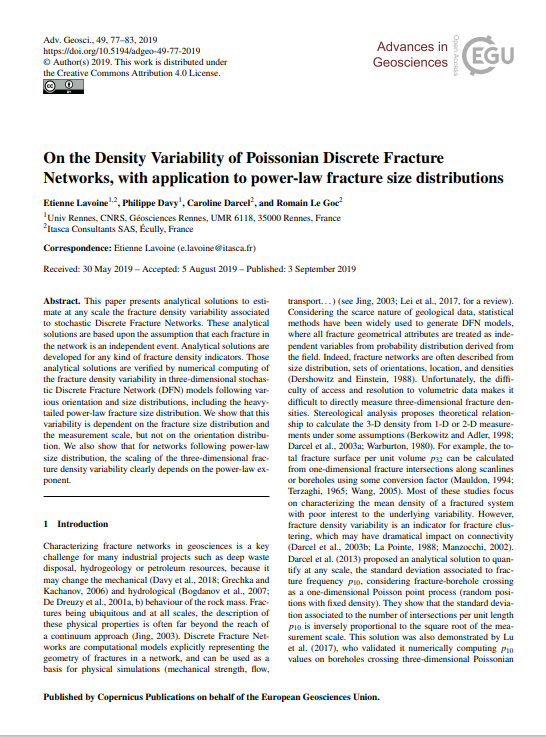
On the Density Variability of Poissonian Discrete Fracture Networks, with application to power-law fracture size distributions
This paper presents analytical solutions to estimate at any scale the fracture density variability associated to stochastic Discrete Fracture Networks. These analytical solutions are based upon the assumption that each fracture in the network is an independent event. Analytical solutions are developed for any kind of fracture density indicators.

Which fractures are imaged with Ground Penetrating Radar? Results from an experiment in the Äspö Hardrock Laboratory, Sweden
Identifying fractures in the subsurface is crucial for many geomechanical and hydrogeological applications. Here, we assess the ability of the Ground Penetrating Radar (GPR) method to image open fractures with sub-mm apertures in the context of future deep disposal of radioactive waste.
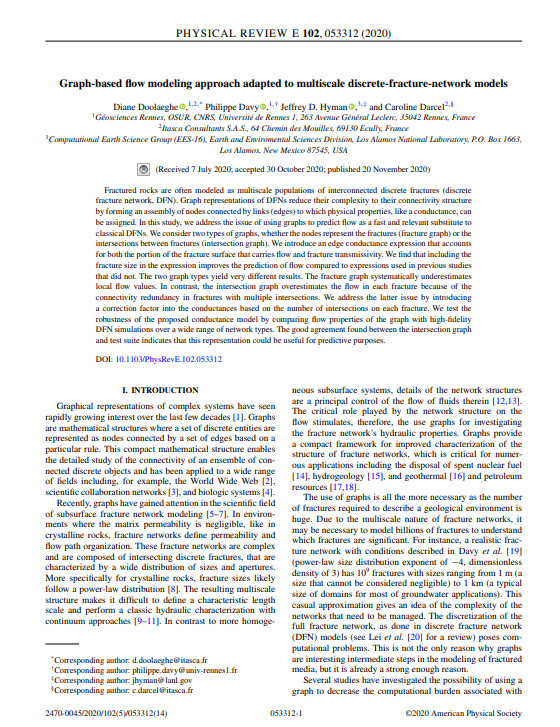
Graph-based flow modeling approach adapted to multiscale discrete-fracture-network models
In this study, we address the issue of using graphs to predict flow as a fast and relevant substitute to classical DFNs. We consider two types of graphs, whether the nodes represent the fractures or the intersections between fractures.
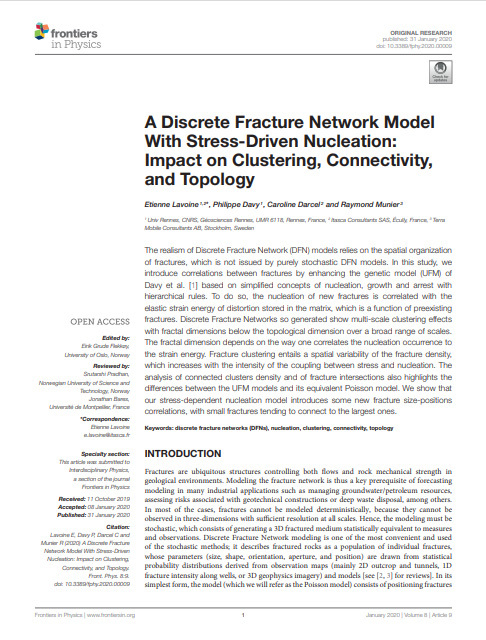
A Discrete Fracture Network Model With Stress-Driven Nucleation: Impact on Clustering, Connectivity, and Topology
The realism of Discrete Fracture Network (DFN) models relies on the spatial organization of fractures, which is not issued by purely stochastic DFN models. In this study, we introduce correlations between fractures by enhancing the genetic model (UFM) of Davy et al. [1] based on simplified concepts of nucleation, growth and arrest with hierarchical rules.
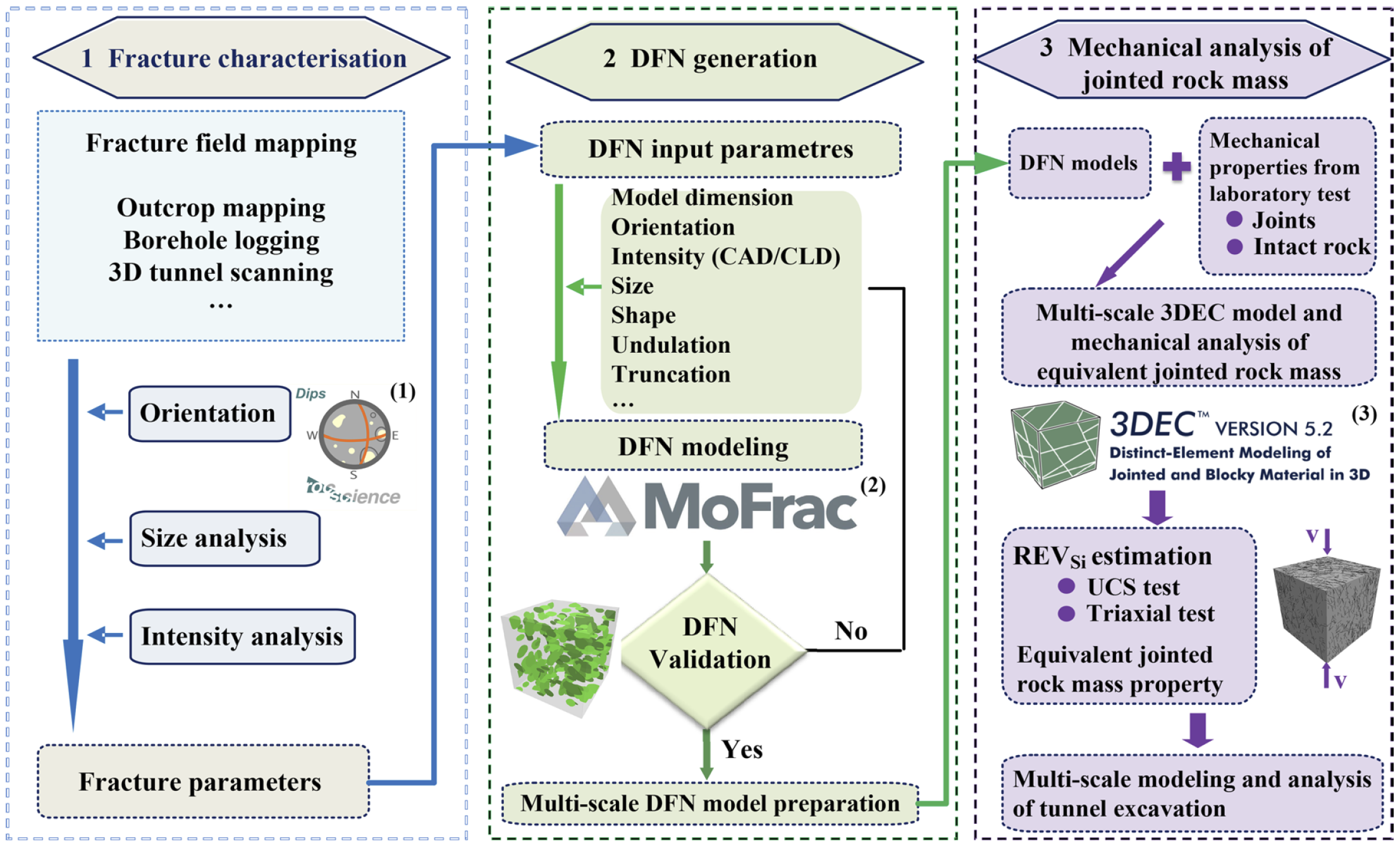
A DFN–DEM Multi‑scale Modeling Approach for Simulating Tunnel Excavation Response in Jointed Rock Masses
Based on the concept of the representative elementary volume (REV) and the synthetic rock mass (SRM) modeling technique, a DFN–DEM multi-scale modeling approach is proposed for modeling excavation responses in jointed rock masses. Based on the DFN models of various scales, equivalent rock mass properties are obtained using 3DEC SRM models. A tunnel excavation simulation using data from the Äspö TAS08 tunnel is conducted to demonstrate the applicability of the proposed multi-scale modeling approach.
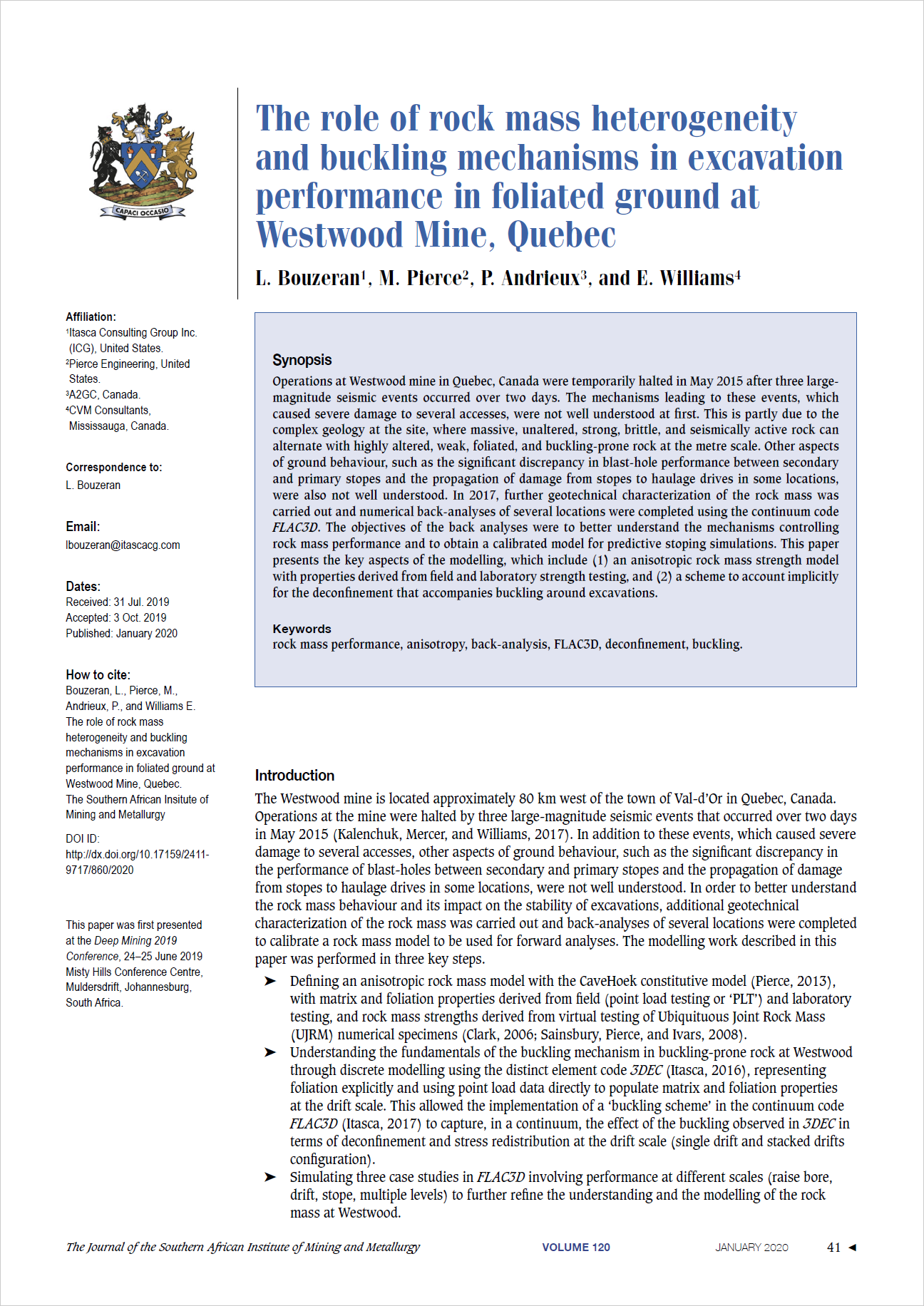
The role of rock mass heterogeneity and buckling mechanisms in excavation performance in foliated ground at Westwood Mine, Quebec
Operations at Westwood mine in Quebec, Canada were temporarily halted in May 2015 after three large-magnitude seismic events occurred over two days. The mechanisms leading to these events, which caused severe damage to several accesses, were not well understood at first. This paper presents the key aspects of FLAC3D back-analysis modelling, which include (1) an anisotropic rock mass strength model with properties derived from field and laboratory strength testing, and (2) a scheme to account implicitly for the deconfinement that accompanies buckling around excavations.
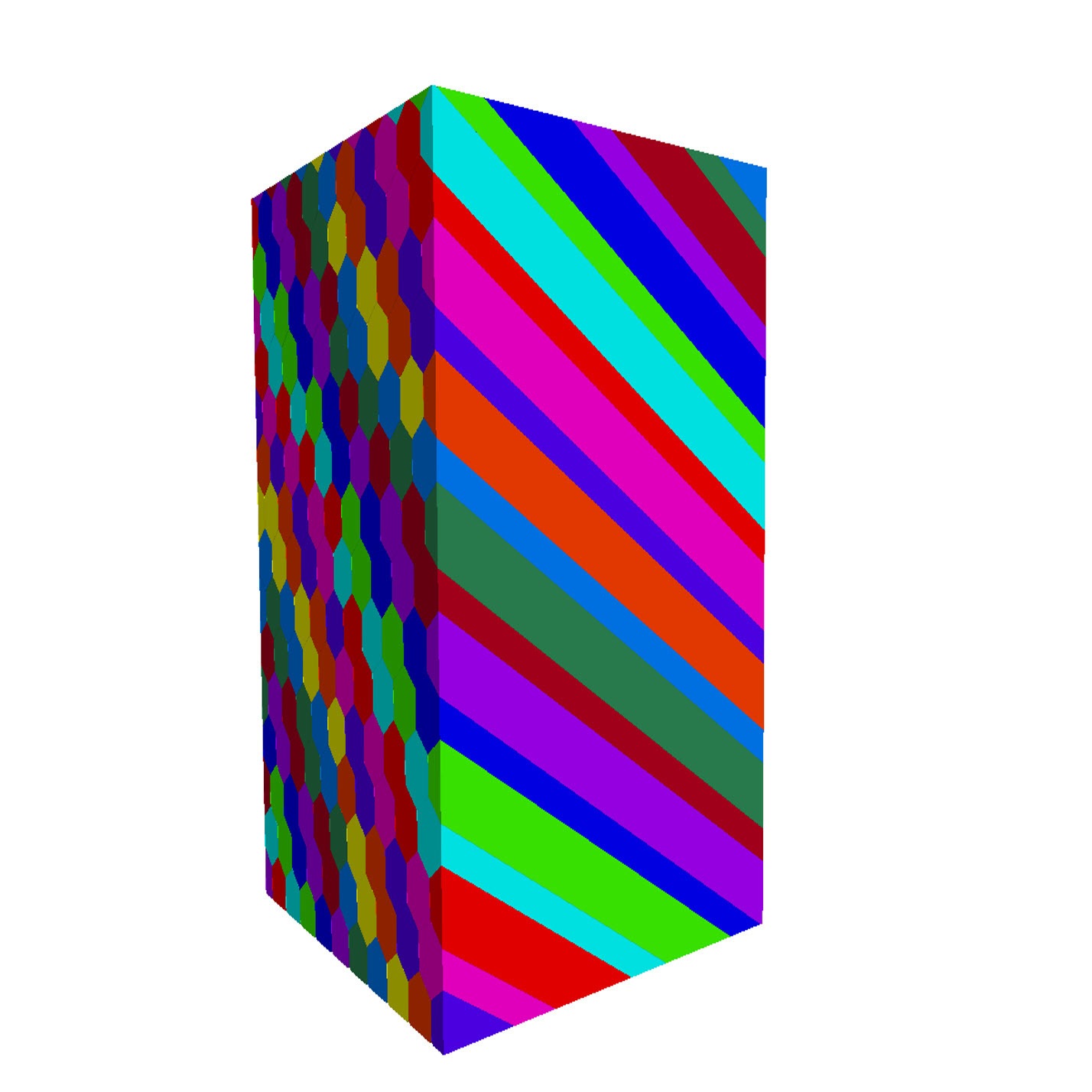
Formulation and Application of a Constitutive Model for Multijointed Material to Rock Mass Engineering
This paper presents the formulation of a constitutive model to simulate the behavior of foliated rock mass. The 3D elastoplastic constitutive model, called Comba, accounts for the presence of arbitrary orientations of weakness in a nonisotropic elastoplastic matrix.
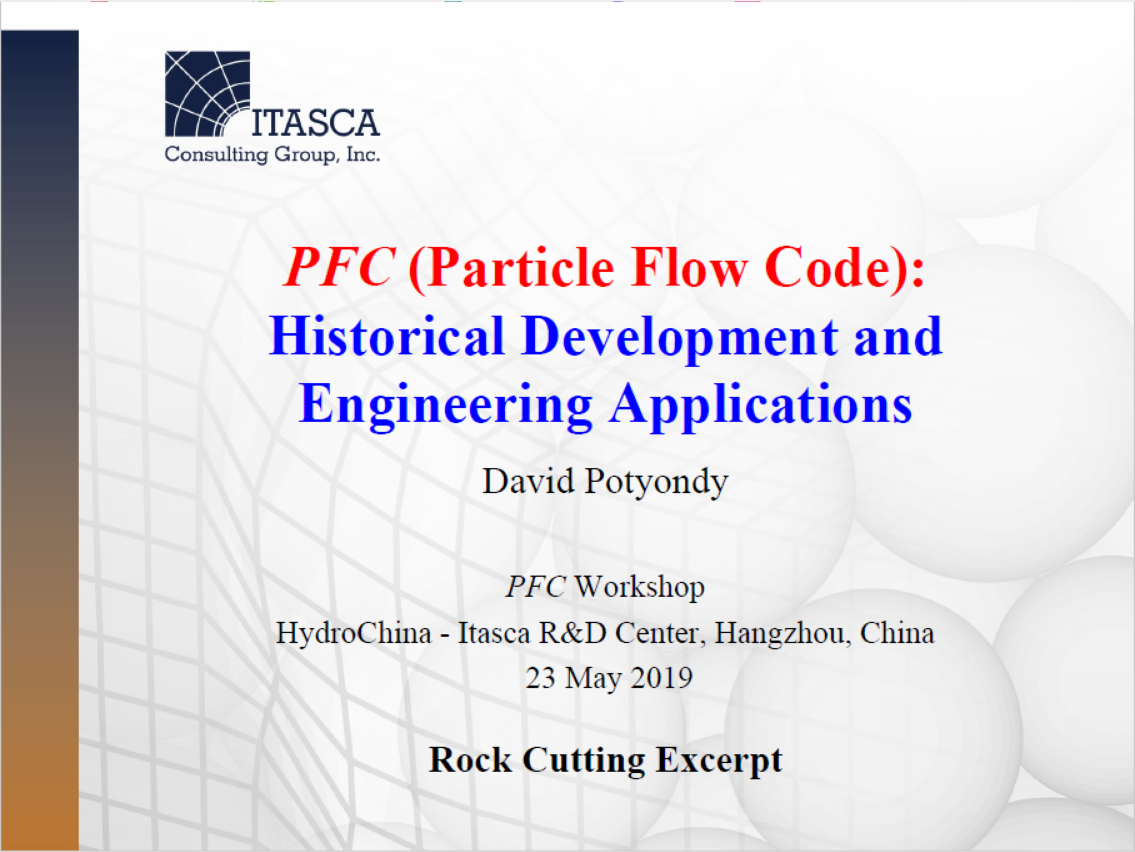
PFC (Particle Flow Code): Rock Cutting Excerpt
Historical development and engineering applications using PFC2D and PFC3D.
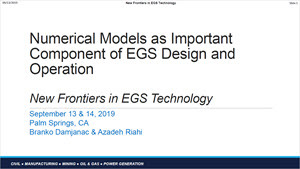
Numerical Models as Important Component of EGS Design and Operation
Calibration of geomechanics models using microseismic data is key to creating reliable predictive tools. This presentation reviews the geomechanical model used for: stress characterization, microseismic modeling to assess the risk associated with faults activation and induced seismicity, and evaluation of designs and operational strategies. Both hydraulic fracturing and hydro-shearing of discrete fracture network were important components of stimulation of EGS and zonal isolation can play a key role in effective stimulation of an EGS along the entire length of the horizontal well.
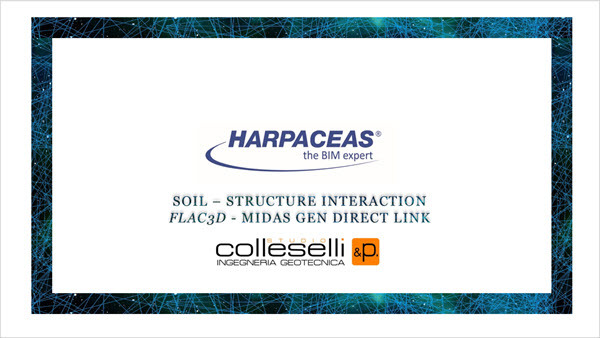
FLAC3D Soil-structure Model of a Building
SOIL – STRUCTURE INTERACTION | FLAC3D - midas GEN DIRECT LINK
Using MINEDWto simulate pore pressure as input for FLAC3Dand 3DEC
It has become common practice to create a three-dimensional (3-D) geomechanical model for the analysis of rock stability.
Packer Testing Program Design and Management
Hydraulic testing using wireline deployed water-inflated packers is becoming a common practice for groundwater characterization at mining sites.
Quantifying the Effect of Localized Depressurization on a Deep Underground Ore Body at the Mcarthur River Mine through Cross Hole Hydraulic Testing and Groundwater Modeling
The McArthur River mine in northern Saskatchewan is the largest single producer of uranium in the world.
Numerical Evaluation of Effectiveness of Drainwells in Dewatering Overburden at Surface Coal Mines
Typical sedimentary sequences overlying coal seams consist of interbedded sandstones, siltstones, shales, and rider coal seams.
The Economic Challenges of Dewatering at the Victor Diamond Mine in Northern Ontario, Canada
The challenges of mining economically have never been greater than under current global financial conditions.
Use of a Finite Element Code to Model Complex Mine Water Problems
Numerical models are now used routinely to predict ground-water inflows to both surface and underground mines and to help design dewatering systems.
Simulation of Three-Dimensional Pore-Pressure Distribution for Slope-Stability Analysis
A 3D groundwater flow model was constructed using MINEDW [1] to simulate pore pressure at the Chuquicamata open pit mine slope in Chile.
Use of a Chemical Transport Code for the Prediction of Gold Heap Leach Production
Itasca Denver, Inc., (Itasca) in conjunction with Newmont Mining Corporation (NMC) developed a numerical model to estimate gold (Au) production from NMC’s heap-leach operations.
Neutral mine drainage water-quality impacts from a form taconite mine
Surface waters at the site of a former Minnesota taconite mine were reported to have solute concentrations elevated with respect to water-quality standards.
A Calibrated Predictive Geochemical Model of Leaching and Attenuation Reactions in a Mine Pit Lake
A geochemical model was developed to predict future water quality of the Cove pit lake in support of site closure and regulatory permitting.
The nexus between groundwater modeling, pit lake chemogenesis and ecological risk from arsenic in the Getchell Main Pit, Nevada, U.S.A.
The proliferation of mine pits that intersect the groundwater table has engendered interest in environmental consequences of the lakes that form after cessation of dewatering.
Depressurising an Underground Ore Body at the McArthur River Mine in Northern Saskatchewan, Canada
Pre-mining depressurising of a deep ore body at the McArthur River mine in northern Saskatchewan was considered to decrease the risk associated with mining near 5 MPa water pressure and increasing the amount of ore that can be extracted.
Mine Dewatering in a Compartmentalized Hydrogeologic Setting at Sishen Mine in South Africa
Sishen mine in South Africa is one of the largest open-pit iron mines in the world.
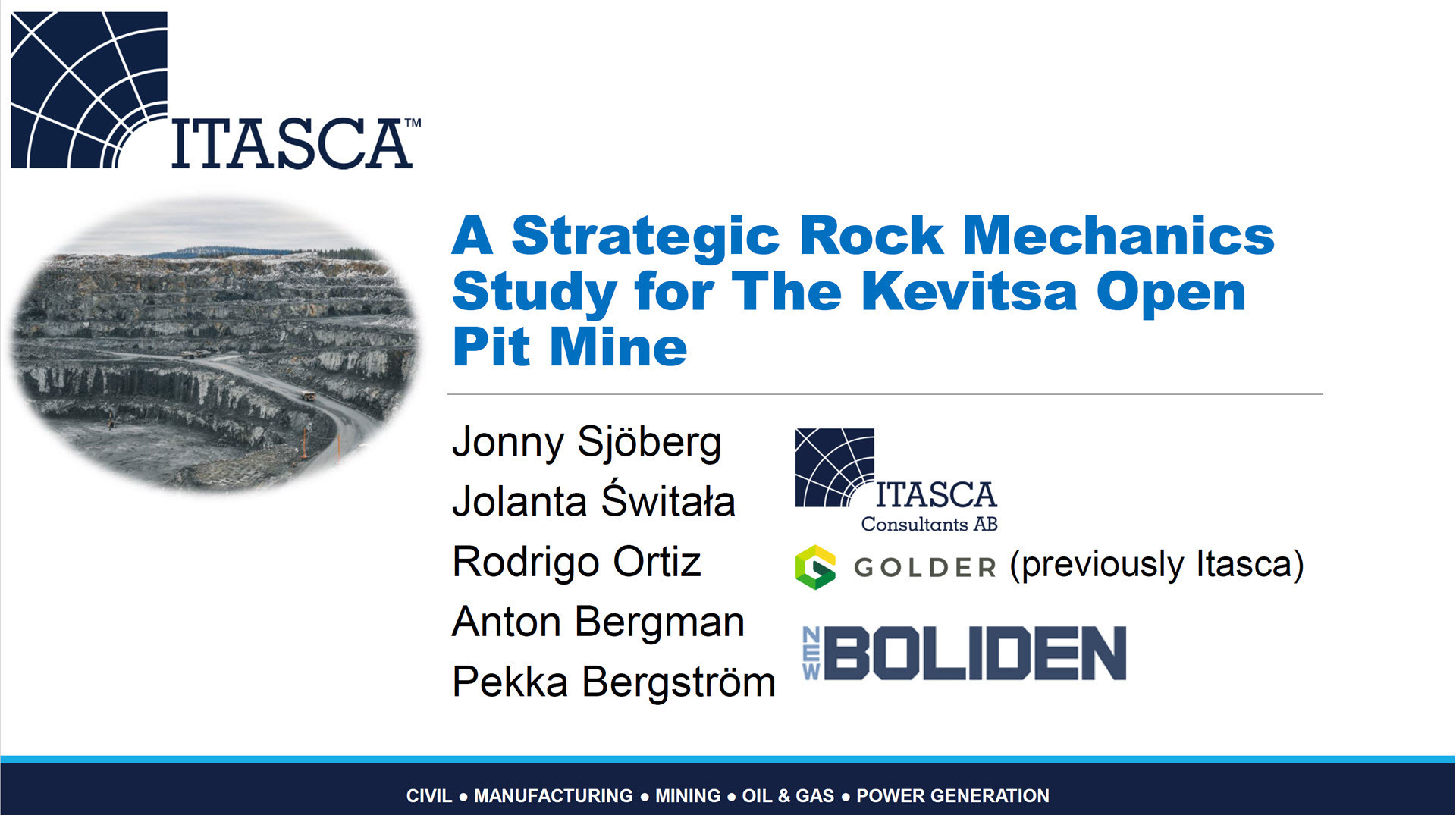
A Strategic Rock Mechanics Study for The Kevitsa Open Pit Mine
The Boliden Kevitsa open pit mine is revising its strategic plan with a new pit optimization project undertaken to investigate an increase in production.
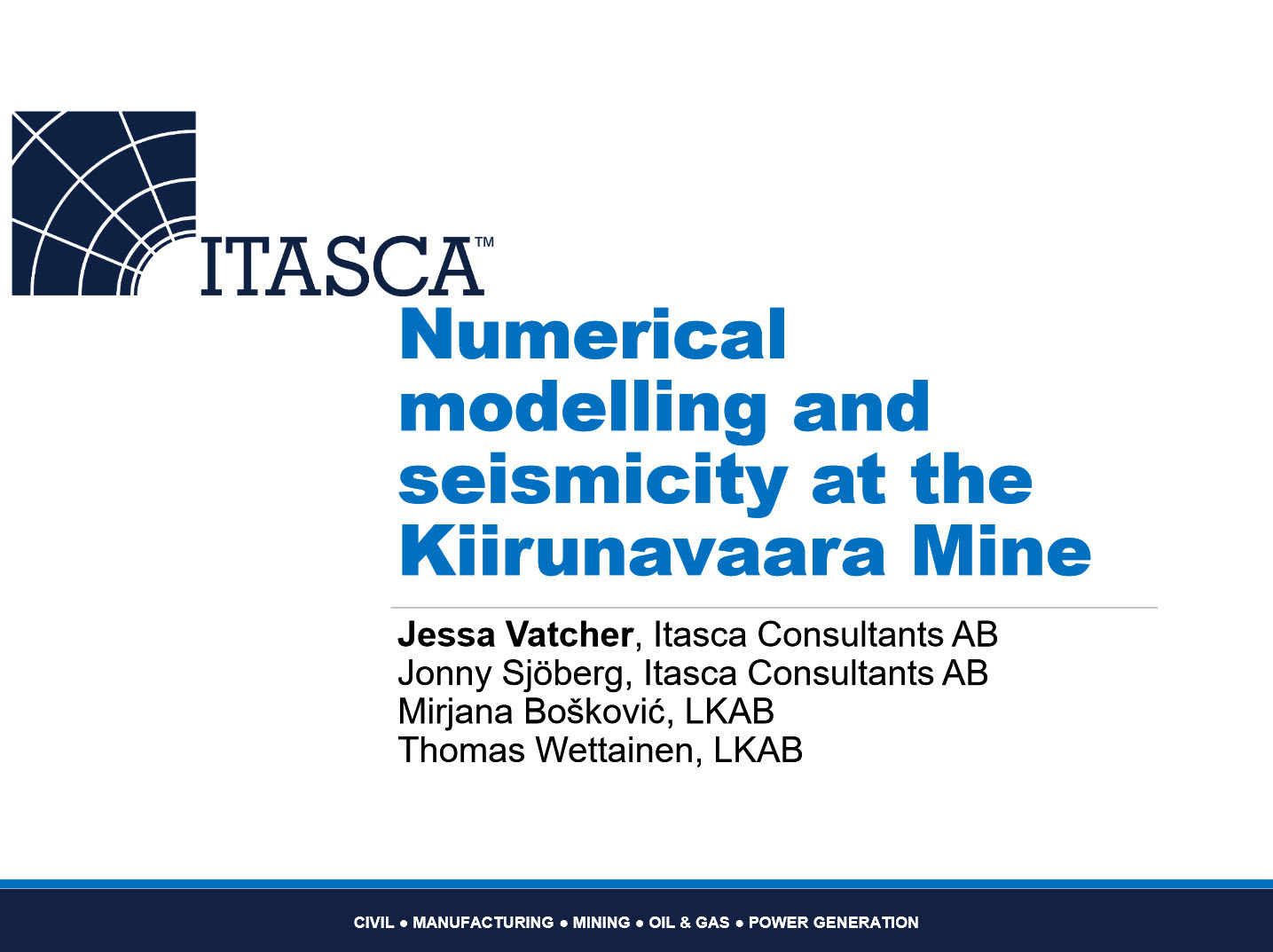
Numerical modelling and seismicity at the Kiirunavaara Mine
What’s happening at the Kiirunavaara Mine?
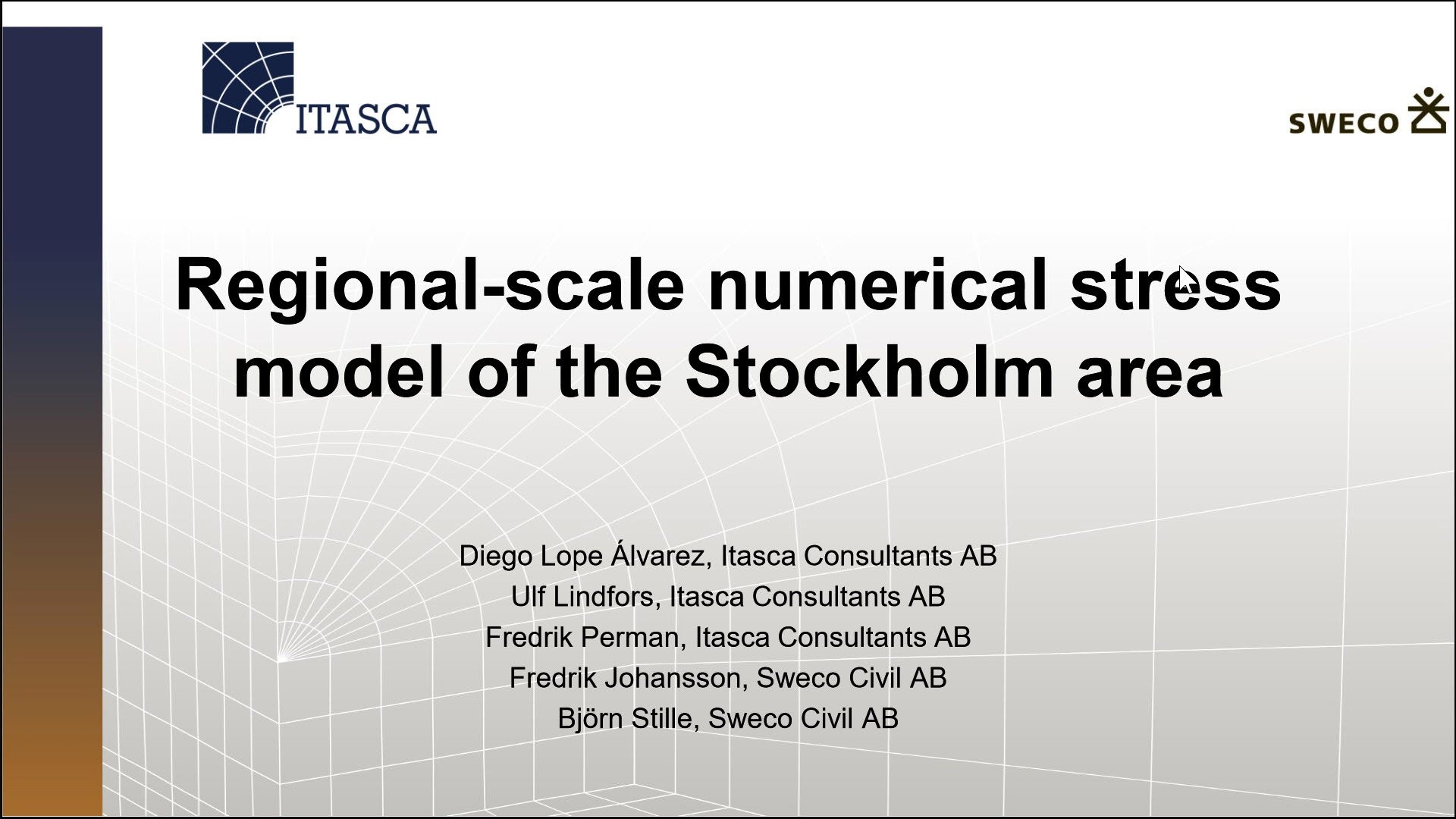
Regional-scale numerical stress model of the Stockholm area
Analyze the initial stress state in the central and southern areas of Stockholm for the Metro to Nacka and Southern Stockholm.
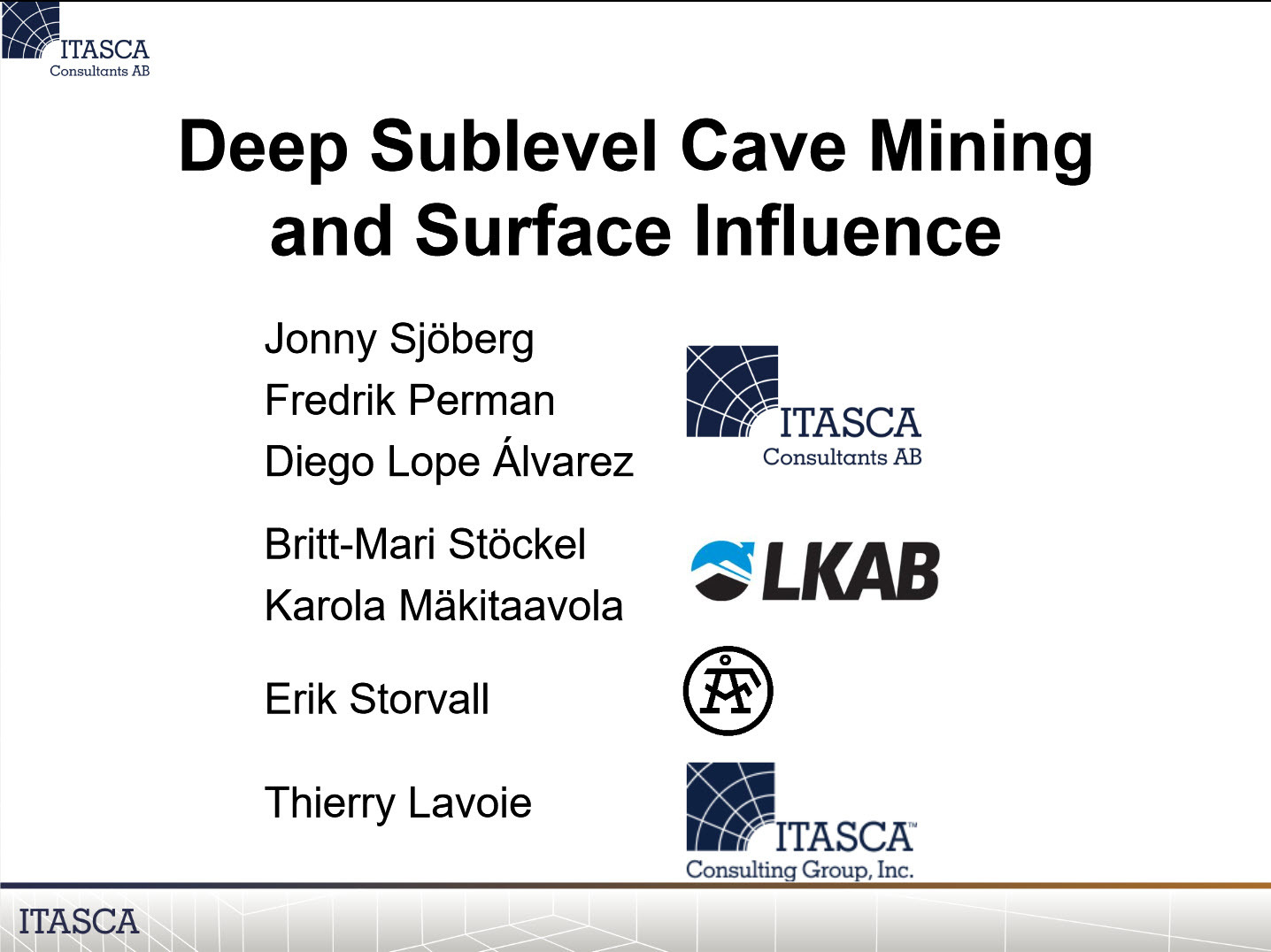
Deep Sublevel Cave Mining and Surface Influence
With increasing depth, higher stress and more difficult mining. With increasing depth is there more ground surface effects or less?
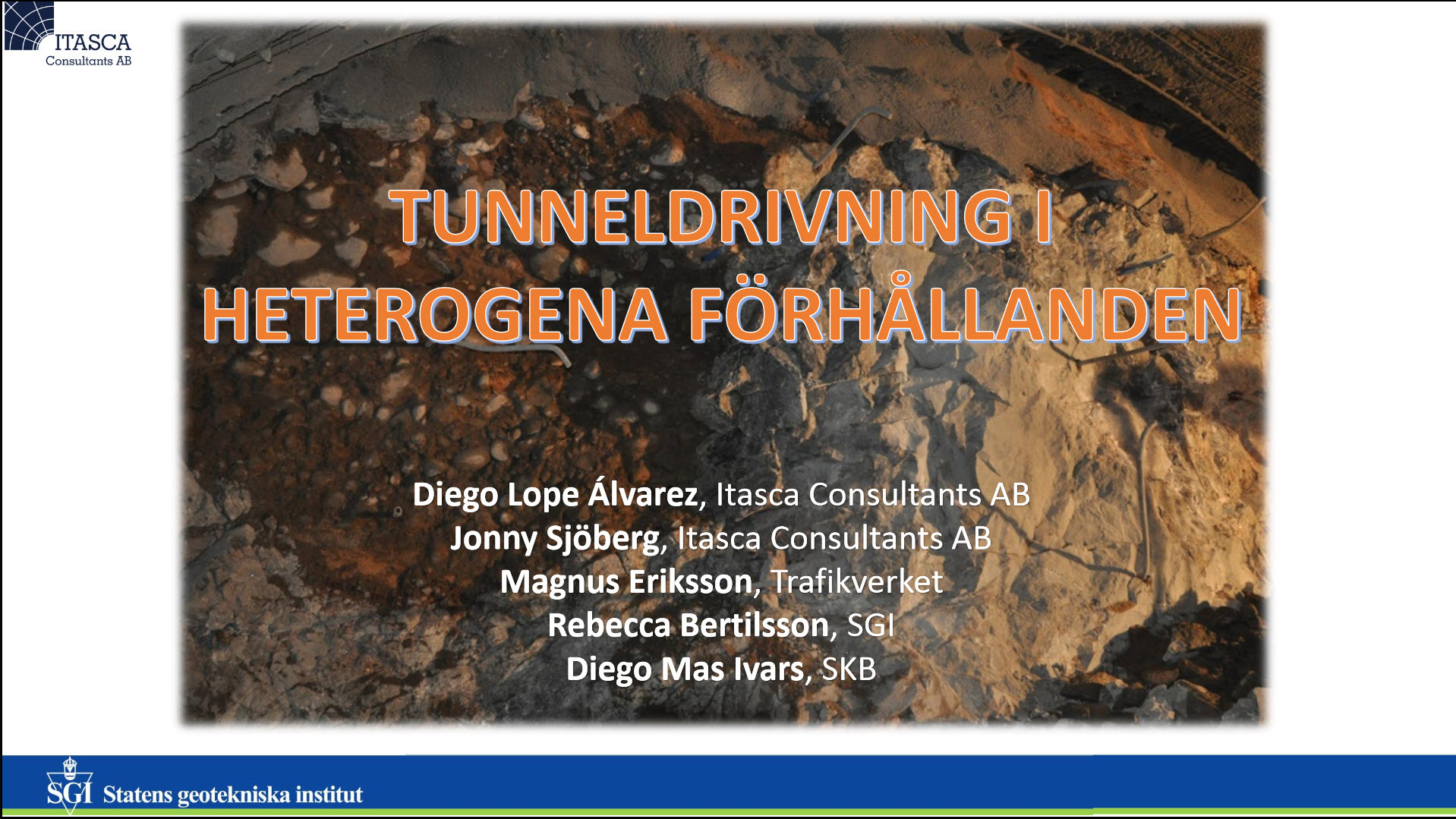
Tunneldrivning i heterogena förhållanden
InledningProblem: Brist på erfarenhet av tunneldrivning i heterogena förhållanden med konventionell uttagsteknik (borrning och sprängning).
Mål: Fördjupa kunskapen och förståelse av brott och deformationsmönster vid dessa förhållanden.
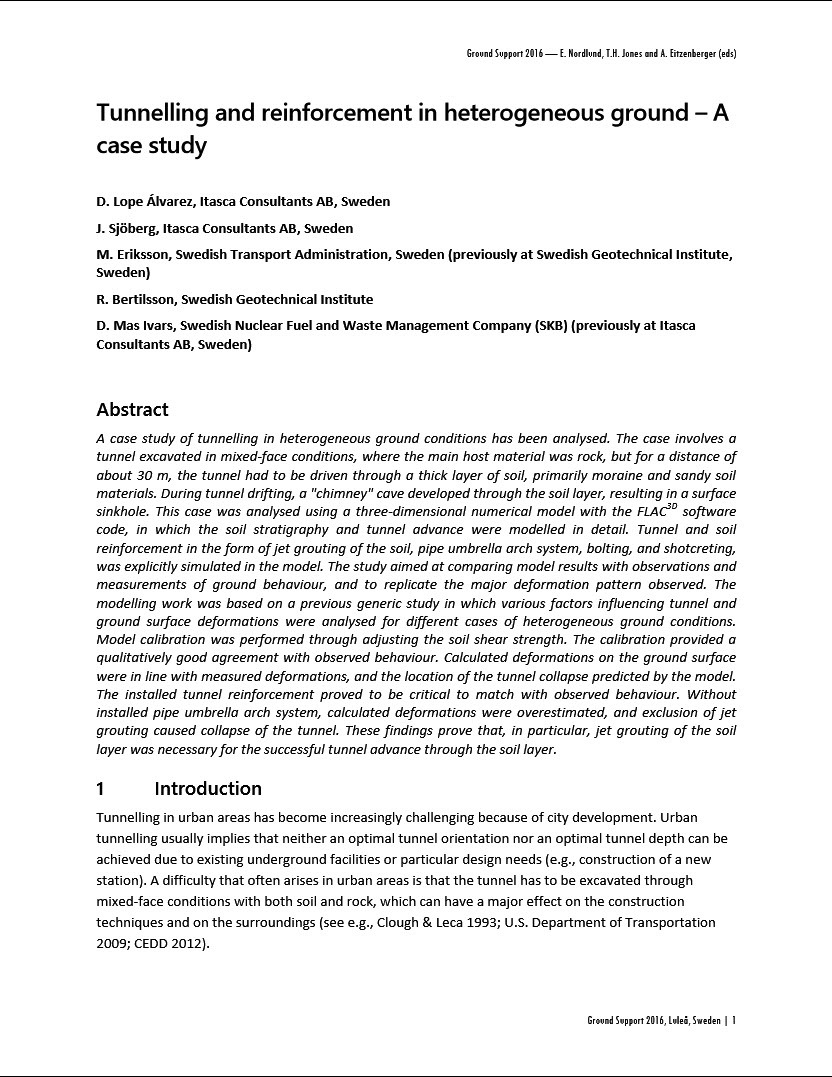
Tunnelling and reinforcement in heterogeneous ground – A case study
Abstract
A case study of tunnelling in heterogeneous ground conditions has been analysed. The case involves a tunnel excavated in mixed-face conditions, where the main host material was rock, but for a distance of about 30 m, the tunnel had to be driven through a thick layer of soil, primarily moraine and sandy soil materials.During tunnel drifting, a "chimney" cave developed through the soil layer, resulting in a surface sinkhole.This case was analysed using a three-dimensional numerical model with the FLAC3D software code, in which the soil stratigraphy and tunnel advance were modelled in detail. Tunnel and soil reinforcement in the form of jet grouting of the soil, pipe umbrella arch system, bolting, and shotcreting, was explicitly simulated in the model. The studyaimed at comparing model results with observations and measurements of ground behaviour, and to replicate the major deformation pattern observed. The modelling work was based on a previous generic study in which various factors influencing tunnel and ground surface deformations were analysed for different cases of heterogeneous ground conditions.Model calibration was performed through adjusting the soil shear strength. The calibration provided a qualitatively good agreement with observed behaviour. Calculated deformations on the ground surface were in line with measured deformations, and the location of the tunnel collapse predicted by the model. The installed tunnel reinforcement proved to be critical to match with observed behaviour. Without installed pipe umbrella arch system, calculated deformations were overestimated, and exclusion of jet grouting caused collapse of the tunnel. These findings prove that, in particular, jet grouting of the soil layer was necessary for the successful tunnel advance through the soil layer.
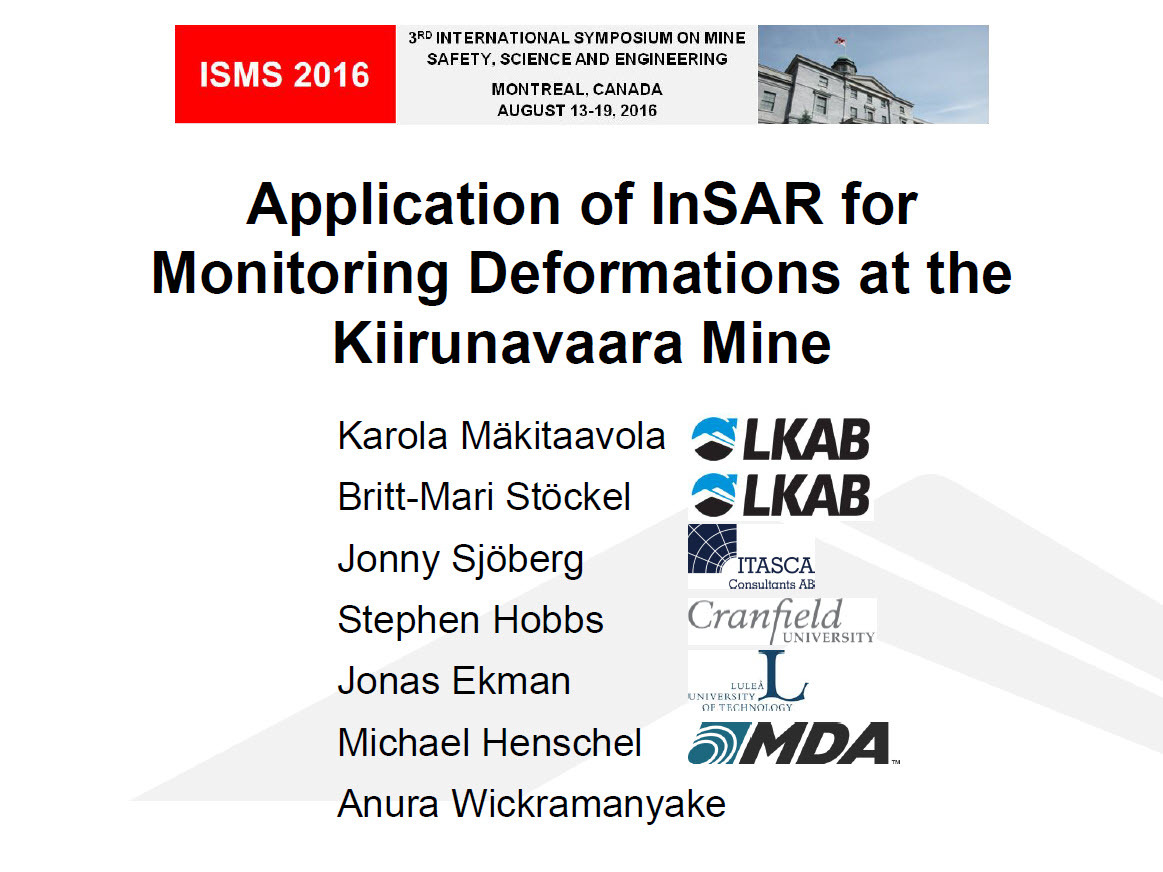
Application of InSAR for Monitoring Deformations at the Kiirunavaara Mine
Assess the use InSAR technology for LKAB's purposes - as a replacement and/or complement to current GPS measurements.
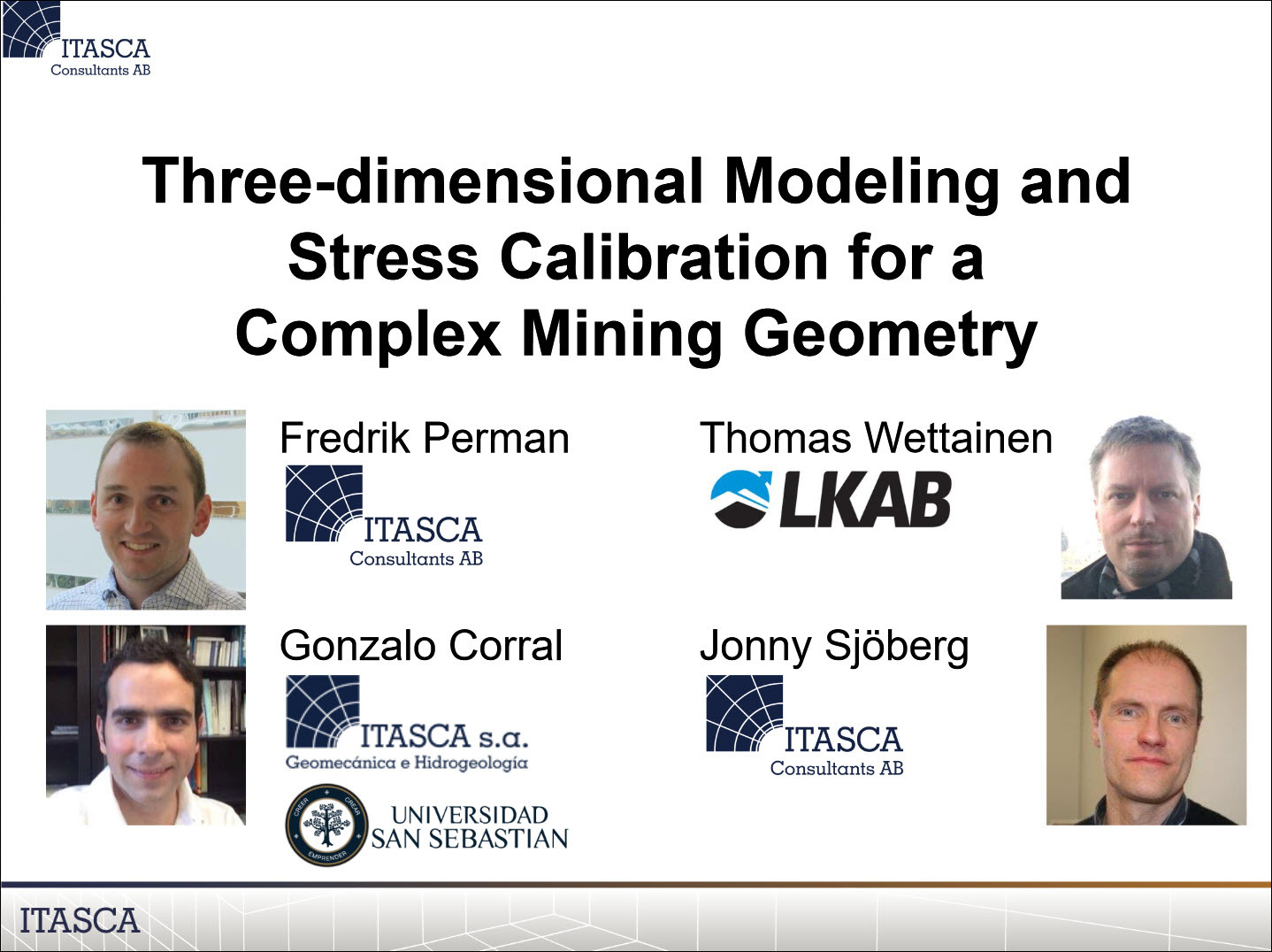
Three-dimensional Modeling and Stress Calibration for a Complex Mining Geometry
Study stress situation for potential continued mining towards greater depths; stress calibration against stress measurements using numerical modeling; and use of calibrated model to study stresses at existing infrastructure, study stresses at potential future haulage level locations, and as input to local models.
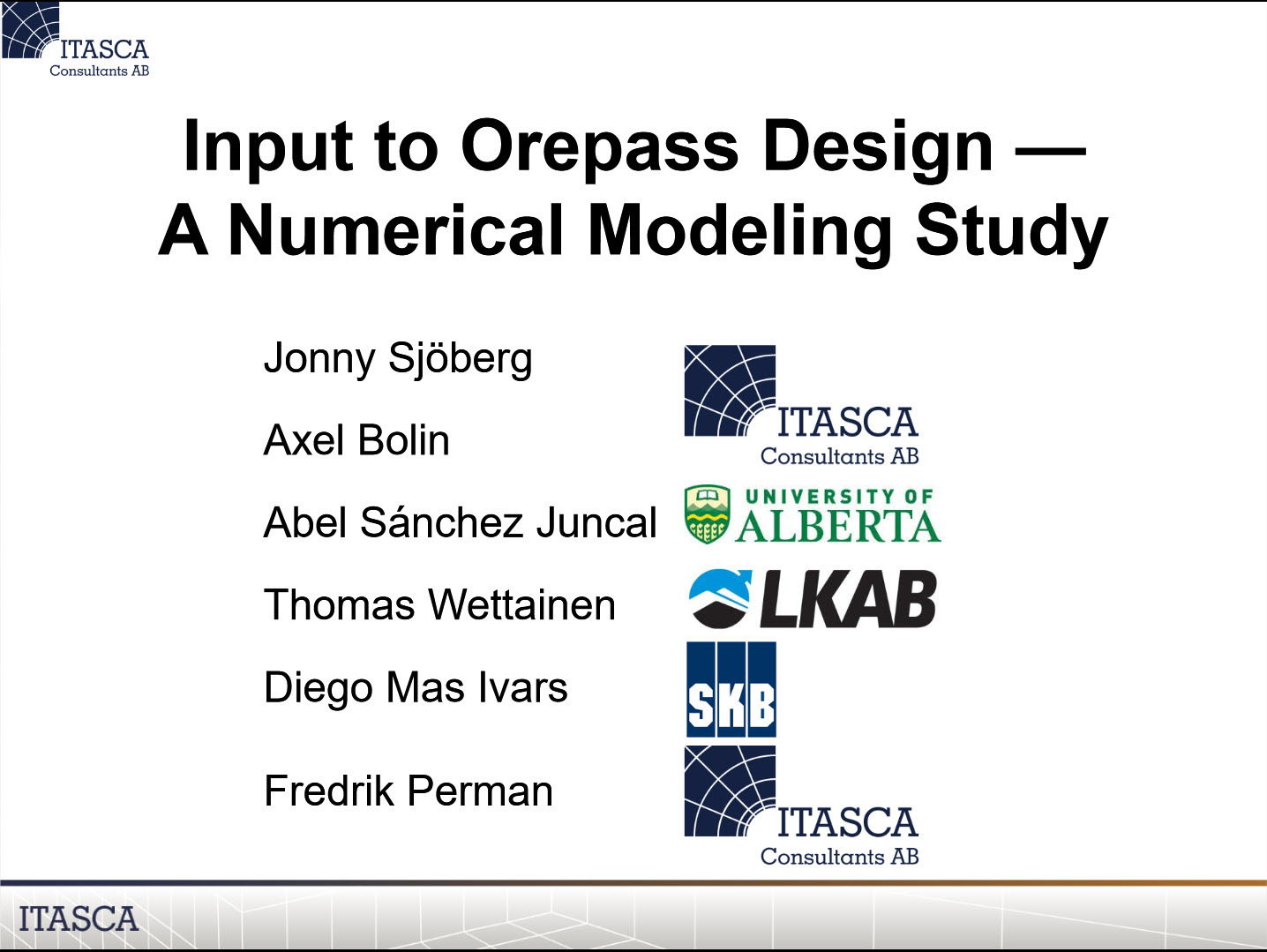
Input to Orepass Design — A Numerical Modeling Study
Orepass design guidelines required for potentially continued mining at depth. Rock strength and stress state were validated through comparison with observed fallouts in orepasses and shafts and the optimal orientation and location of orepasses for future mining were determined.
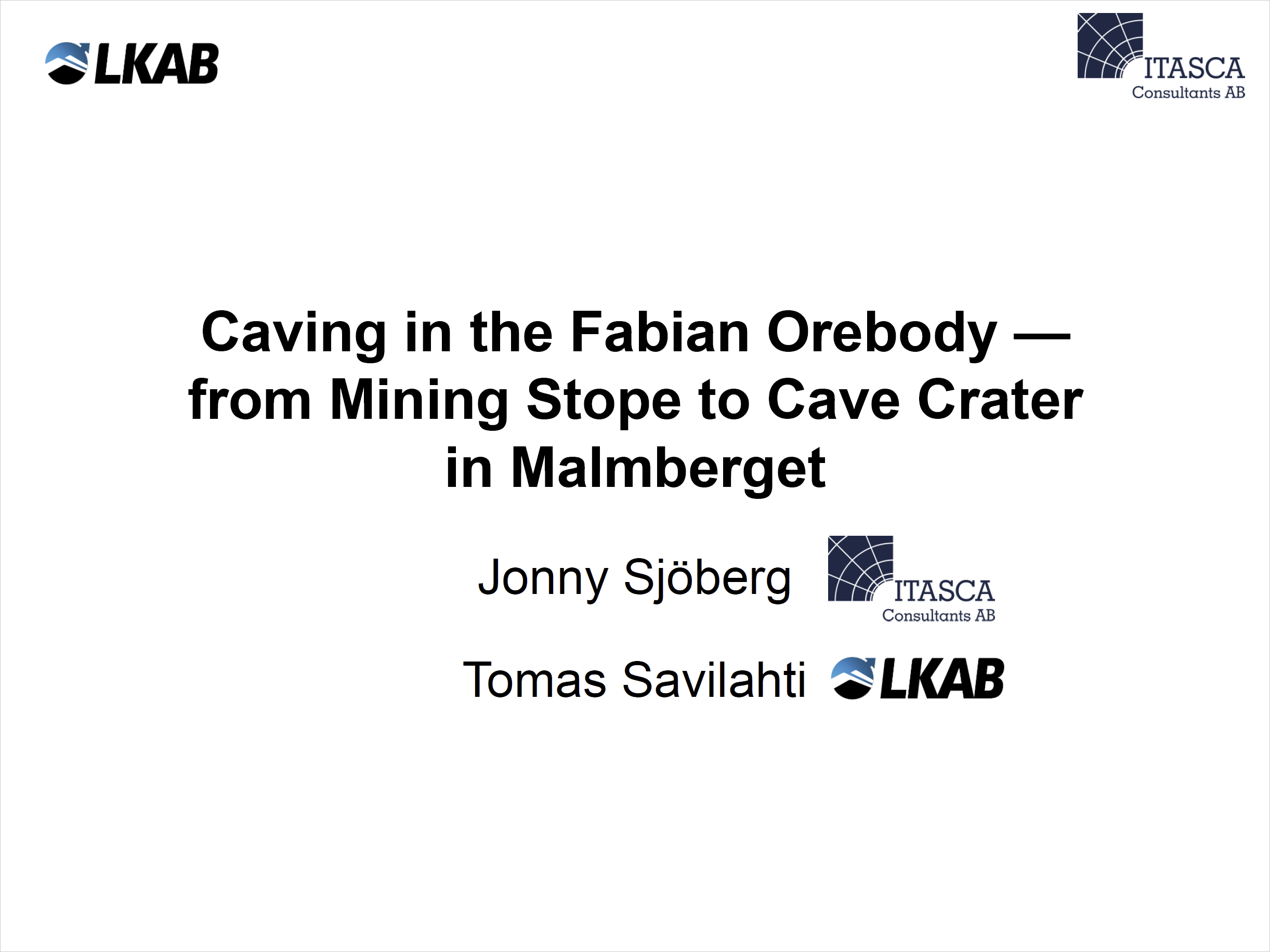
Caving in the Fabian Orebody —from Mining Stope to Cave Crater in Malmberget
The Fabian orebody is a non-daylighting iron orebody in the LKAB Malmberget Mine in northern Sweden. During 2010, a prognosis of the cave development in the Fabian area was developed, based on compilation and analysis of all available material. In March 2012, a new cave crater formed on the ground surface above the Fabian orebody, similar to what was predicted. The prognosis is compared with observations of the caving and the differences and implications quantified. A program for continued monitoring of mining-induced deformation in Malmberget is also described and a criterion for allowable mining-induced surface deformations is proposed.
FLAC3D mesh and zone quality
Mesh quality is crucial for the stability, accuracy, and fast convergence of numerical simulations. However, given the geometrical complexity of some models and the tools available for mesh creation, it is often necessary to accept meshes that deviate significantly from the known ideal shape.
Numerical modeling of rock blasting: Validation tests for Blo-Up 2.5
As part of the Hybrid Stress Blast Model (HSBM) project, Itasca has developed software to model the rock blasting process.
